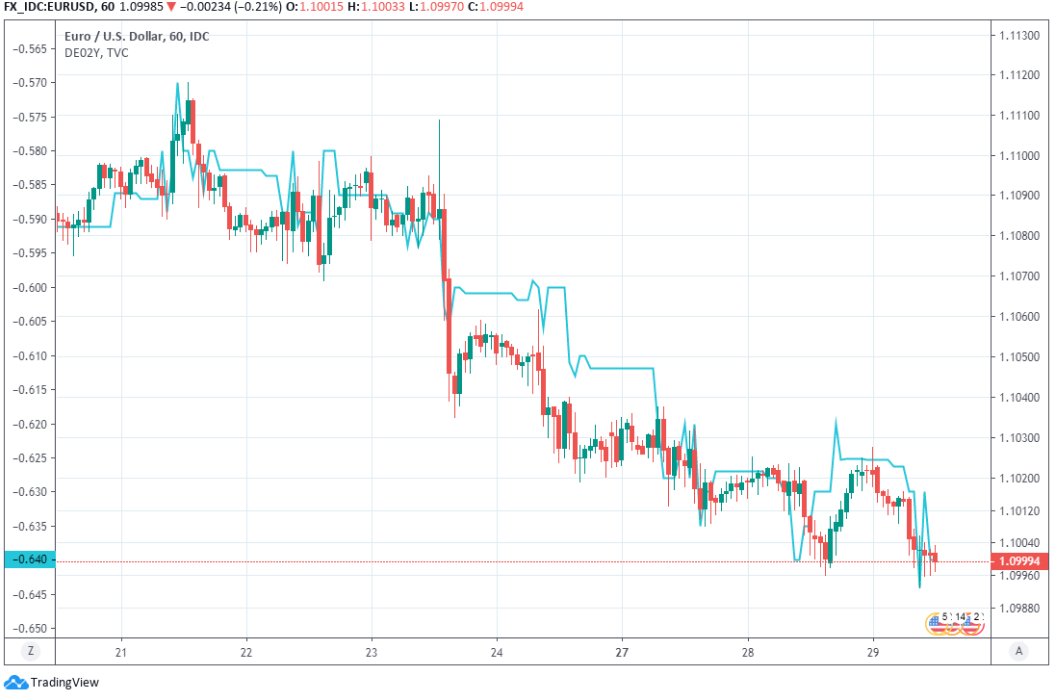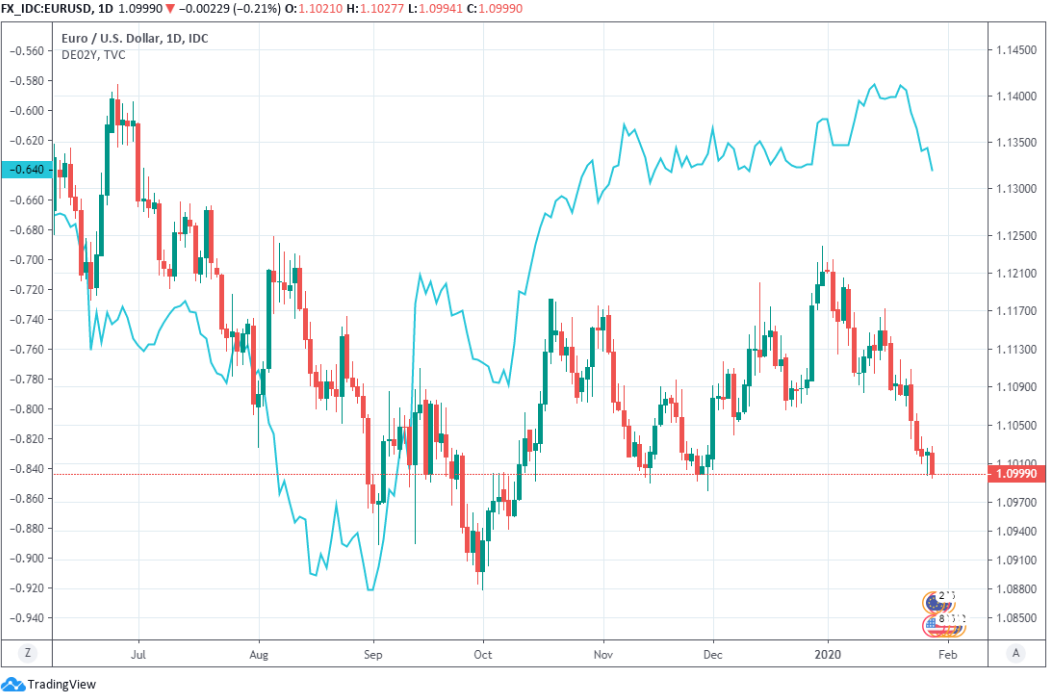The Euro-Dollar Rate Eyes Federal Reserve Nervously as Risk of a Range-break Lower Builds
- Written by: James Skinner
-
- EUR remains at bottom of multi-month range ahead of Fed.
- TD sees a "directionless" EUR no matter what Fed does.
- EUR needs growth recovery, or a major USD turn lower.
- German government upgrades 2020 GDP growth forecast.
- But China Gov says coronavirus could see its growth sub 5%.
- On assumption outbreak peaks by mid-Feb, ends in March.
- Says impact could be "significantly higher" than SARS virus.

© Christian Müller, Adobe Stock
- EUR/USD Spot rate: 1.1000, down 0.19% today.
- Indicative bank rates for transfers: 1.0621-1.0698
- Transfer specialist indicative rates: 1.0846-1.0902 >> Get your quote now
The Euro continued to test the bottom of a multi-month range ahead of the Federal Reserve (Fed) interest rate decision on Wednesday and is tipped to remain "directionless" no matter what the bank does this evening, although coronavirus concerns are increasingly threatening a breakout to the downside.
Europe's single currency was lower relative to the Dollar, Pound and Yen on Wednesday but higher against other European rivals as well the commodity-backed dollars of New Zealand and Australia. This marks the third day in which the Euro has tested the bottom of key support against a Dollar that could well end up being lifted by the Fed after the European close.
Consensus is looking for the Fed to leave its interest rate unchanged at 1.75% this month, which will leave the market looking to the accompanying statement and subsequent press conference for clues on what might be just around the corner. The decision and statement are due out at 19:00 and the press conference starts at 19:30, while there's a risk that all will be released amid a barrage of criticism and complaint from President Donald Trump.
"The chairman will undoubtedly cite the Phase One deal, which was announced shortly after the December meeting, although we expect he will still suggest more downside than upside risk for the outlook," says Mazen Issa, a strategist at TD Securities. "We will be interested in any indication from the chairman of what would constitute a "material" change in the outlook."
The Fed should get smart & lower the Rate to make our interest competitive with other Countries which pay much lower even though we are, by far, the high standard. We would then focus on paying off & refinancing debt! There is almost no inflation-this is the time (2 years late)!
— Donald J. Trump (@realDonaldTrump) January 28, 2020
The Fed and its rate setters have consistently said of late that it would require a "material change" of its outlook for GDP growth of around 2% in 2020, with near-target inflation and full employment in order to prompt further policy action. And so far the economy appears to be delivering those forecasts, although the bank cut U.S. rates three times last year to defend the domestic economy against a trade-war-induced global slowdown.

Above: Euro-to-Dollar rate shown at hourly intervals alongside 2-year German government bond yield.
Fed policy has been supportive of the Dollar, not least of all against the Euro and mainly because it's left the greenback with one of the highest cash rates of major economies and at a time when the Euro is weighed down by the negative rate and quantitative easing policies of the European Central Bank (ECB).
"Our global growth tracking suggests that a recovery may be in the offing. While wary that this could be a false positive, this re-acceleration is not enough to offset the negative carry dynamics associated with the EUR — a pro-cyclical currency," says TD's Issa.
The potential problem for the Euro Wednesday is that coronavirus just might have qualifed as a "material" risk to the Fed's outlook even if it hadn't already shown up in the U.S. - which it has - so Chairman Jerome Powell might make that clear in either the statement or press conference. And although any warnings of more rate cuts to come in the months ahead might initially give the Euro a boost, they'd be unlikely to sustain it for very long.
This is because the Euro needs either a continental pickup in economic growth or a marked turn lower in the Dollar to have any hope of a breakout to the upside from the 1.10-to-1.12 range that's prevailed since October 2019.
However, and increasingly in light of mounting fears of a pandemic stemming from China's new coronavirus, both of those conditions are unlikely to be satisfied in the immediate future.

Above: Euro-to-Dollar rate shown at 4-hour intervals alongside 2-year German government bond yield.
"The most interesting issue that Powell might tackle is how the Fed might react to the Coronavirus leading to a pandemic in the US. Expressing mindfulness of this issue might be one way that Powell could offset any USD rally," says Stephen Gallo, European head of FX strategy at BMO Capital Markets.
Coronavirus has spread to all 31 of China's provinces, according to the National Health Commission, with the number of confirmed infections rising from 4,515 to 5,974 between Tuesday and Wednesday.
There were 1,239 "severe cases" as of midnight on January 28, up from 917 the previous day, while the number of fatalities increased from 106 to 132. And the number of suspected cases has risen from 6,973 to 9,239.
A Chinese government economist was reported elsewhere Wednesday to have warned that Chinese GDP growth could fall from around 6% annualised, to less than 5% in the first quarter of 2020 as a result of the disease.
However, that projection requires the outbreak to "peak" by mid-February and be over entirely by the end of March.
"The EURUSD is perched on the 1.1000 knife edge ahead of the FOMC meeting, where the market will focus on how the Fed signals its intentions around the continued pace of balance sheet growth. As well, the level of concern on the fallout from the coronavirus situation will garner attention," says John Hardy, chief FX strategist at Saxo Bank.
Coronavirus is now in at least 17 locations outside of mainland China including Germany and France, according to the UK government.

Above: Euro-to-Dollar rate shown at daily intervals alongside 2-year German government bond yield.
That's testament to the potential the virus has to cause disruption across the globe including in Europe, although a Chinese economic calamity resulting from the disease would on its own be enough to further damage the Eurozone outlook and weigh on the Euro.
After all, Germany's manufacturing sector was badly wounded last year despite Europe not being directly involved in the U.S.-China trade war.
And in Wuhan of Hubei province, the epicentre of the outbreak, residents are already locking themselves away in order to avoid infection. That's seen the local economy grind to a standstill and the city become a ghost town - more on that here - with the Hubei governor having instructed companies Wednesday to remain shut until February 13. But ALL of China's provinces are now effected and the authorities are yet to get a grip on the spread of the virus.
Any continuation of the economic shut-in trend would be sure to have consequences far beyond the borders of China but especially for Germany and some other manufacturing-intensive European economies. Ironically, Chinese economists warned of increasing downside for their economy just as the German government upgraded its forecast for 2020 GDP growth, which has risen from 1% to 1.1%, on Wednesday.
"News of virus spread aside, anecdotal reports of activity on the ground across large portions China having ground to a halt are a concern for near term demand of nearly everything, as are announcements of reductions, and even total halts in the case of British Airways, to air travel in and out of China. In short, we remain cautious on risk appetite," Hardy says.




